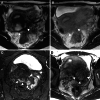Endometriosis, a common but enigmatic disease with many faces: current concept of pathophysiology, and diagnostic strategy
- PMID: 38658503
- PMCID: PMC11286651
- DOI: 10.1007/s11604-024-01569-5
Endometriosis, a common but enigmatic disease with many faces: current concept of pathophysiology, and diagnostic strategy
Abstract
Endometriosis is a benign, common, but controversial disease due to its enigmatic etiopathogenesis and biological behavior. Recent studies suggest multiple genetic, and environmental factors may affect its onset and development. Genomic analysis revealed the presence of cancer-associated gene mutations, which may reflect the neoplastic aspect of endometriosis. The management has changed dramatically with the development of fertility-preserving, minimally invasive therapies. Diagnostic strategies based on these recent basic and clinical findings are reviewed. With a focus on the presentation of clinical cases, we discuss the imaging manifestations of endometriomas, deep endometriosis, less common site and rare site endometriosis, various complications, endometriosis-associated tumor-like lesions, and malignant transformation, with pathophysiologic conditions.
Keywords: Deep endometriosis; Endometrioma; Endometriosis; Magnetic resonance imaging (MRI); Malignant transformation.
© 2024. The Author(s).
Figures




















References
-
- Zondervan KT, Becker CM, Missmer SA. Endometriosis. N Engl J Med. 2020;26(382):1244–56. - PubMed
-
- Shafrir AL, Farland LV, Shah DK, Harris HR, Kvaskoff M, Zondervan K, et al. Risk for and consequences of endometriosis: A critical epidemiologic review. Best Pract Res Clin Obstet Gynaecol. 2018;51:1–15. - PubMed
-
- Saunders PTK, Horne AW. Endometriosis: Etiology, pathobiology, and therapeutic prospects. Cell. 2021;27(184):2807–24. - PubMed
-
- Irving JA, Clement PB. Diseases of the peritoneum. In: Kurman RJ, editor. Blaustein’s pathology of the female genital tract. 7th ed. New York: Springer-Verlag; 2018. p. 771–840.
-
- Stewart CJR, Ayhan A, Fukunaga M, Huntsman DG (2020). Endometriosis and related conditions. In: WHO Classification of Tumours Editorial Board, ed. WHO classification of tumours female genital tumours, 5th ed. Lyon: IARC Library Cataloguing-in-Publication Data:169–74.
Publication types
MeSH terms
LinkOut - more resources
Full Text Sources
Medical

